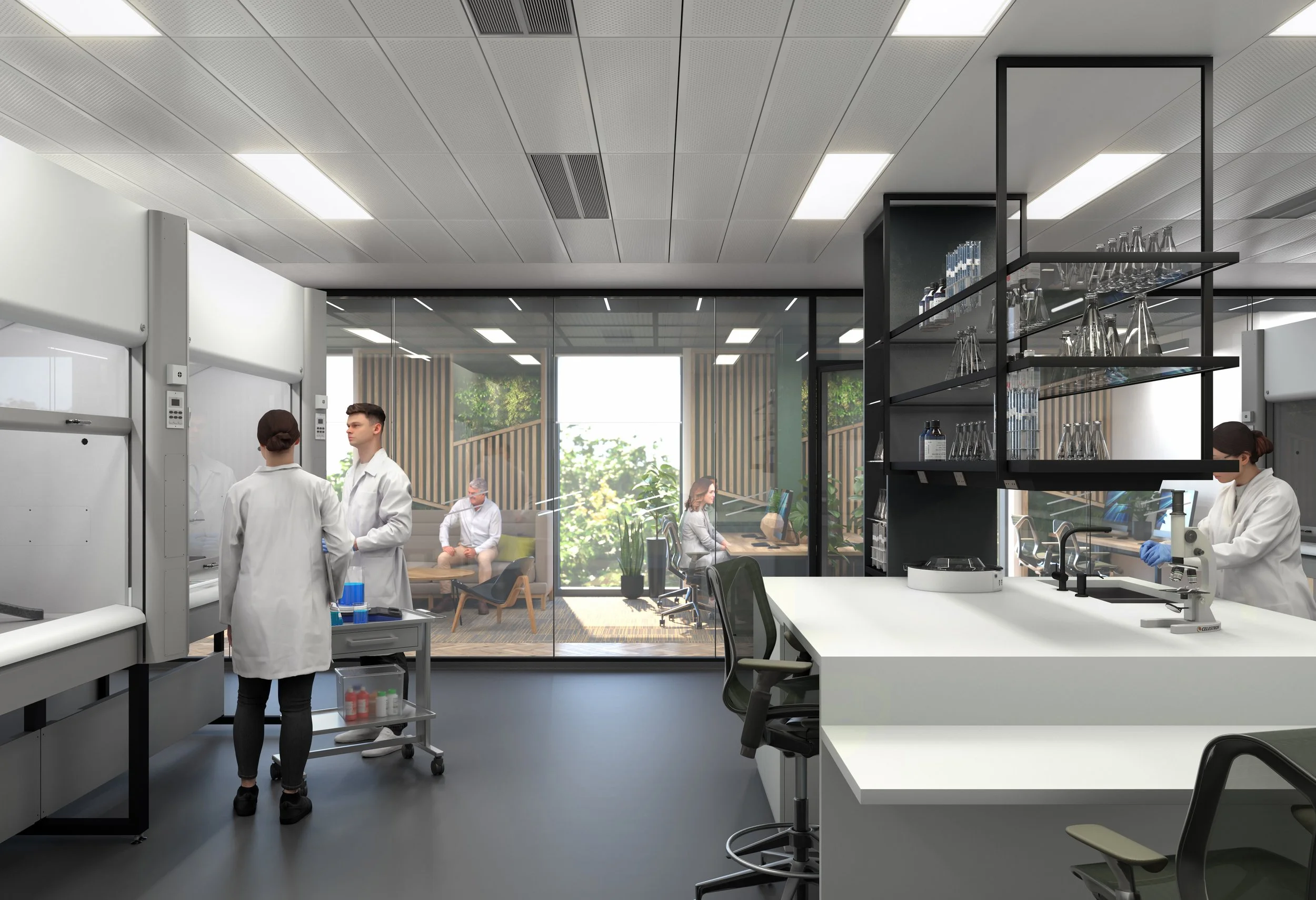Cambridge is one of the United Kingdom’s most important centres for nuclear magnetic resonance spectroscopy. Across chemistry, biochemistry, structural biology and materials science, the city hosts a dense array of high field spectrometers and specialist staff. For any modern NMR facility Cambridge is not merely a scientific resource but an engineering system. Superconducting magnets are acutely sensitive to floor vibration, acoustic noise and electromagnetic interference, so the surrounding building fabric must be designed as carefully as the instruments themselves.
This article surveys the core NMR infrastructure in Cambridge, explains how it underpins every major structural chemistry lab, and examines the increasing importance of the vibration-controlled building including the role of the new South Cambridge Science Centre SCSC which has been engineered with NMR suitable vibration performance.
The NMR Landscape in Cambridge
Within the University, the Yusuf Hamied Department of Chemistry operates a central NMR facility that provides analytical services to research workers in chemistry, other departments and external users. The facility covers routine and advanced solution state NMR for small molecules, polymers and materials and is integrated with mass spectrometry and other analytical platforms.
The department also hosts a dedicated solid state NMR facility, with two 400 megahertz systems, a 600 megahertz and a 700-megahertz spectrometer, widely used for materials, biomaterials and energy storage research.
Here, magic angle spinning and multi nuclear experiments allow researchers to probe disordered solids, interfaces and complex composite systems that are inaccessible to diffraction methods alone.
In the Department of Biochemistry, the Biomolecular NMR Facility is in the Sanger Building on Tennis Court Road. It provides three spectrometers operating at 500, 600 and 800 megahertz, all equipped with modern cryoprobes, and has core strengths in peptides, proteins, nucleic acids and carbohydrates. This facility is the backbone for solution state structural biology, ligand binding studies and dynamics measurements across the life sciences.
The Medical Research Council Laboratory of Molecular Biology MRC LMB adds another high-end NMR facility Cambridge can call on. LMB’s NMR centre is in a separate purpose built building and houses 500, 600, 700 and 800 megahertz instruments, all with cryoprobes, including an AstraZeneca spectrometer operated jointly with industry scientists. The goal is explicitly collaborative, integrating NMR into a broader structural biology pipeline that also includes X ray crystallography and cryo electron microscopy.
Beyond these, the Department of Earth Sciences operates wide bore NMR magnets such as a 9-point 4 tesla system for geological and materials applications, demonstrating that Cambridge’s NMR usage extends well beyond traditional chemistry and biochemistry into nuclear and earth sciences. Nationally, Cambridge appears as a key node in the United Kingdom NMR network. The Connect NMR UK directory lists high field instruments including 700 to 800 megahertz systems that contribute to shared national capability.
NMR as the Backbone of Structural Chemistry Labs
Together, these facilities underpin almost every structural chemistry lab in the city. In synthetic and mechanistic chemistry, solution state NMR remains the default method for verifying molecular structure and purity, but high field instruments and multidimensional experiments now routinely address
relative and absolute stereochemistry in complex natural products and drug candidates
mechanistic intermediates in organometallic and catalytic cycles
conformational equilibria and non-covalent interactions in supramolecular systems
In materials and solid-state chemistry, the dedicated solid state NMR suite is central to the characterisation of battery materials, glasses and hybrid frameworks, where long range disorder and local environments must be resolved simultaneously.
Structural biology in Cambridge likewise depends on NMR to complement crystallography and cryo EM. The Biochemistry and LMB facilities specialise in proteins, nucleic acids and their complexes, providing information on dynamics, intrinsically disordered regions and weak binding events that are difficult to capture in the crystal or in frozen vitreous ice.
In this sense, NMR is no longer a standalone technique. It is an embedded part of multimodal structural chemistry and biology workflows, where data from different platforms are combined to build coherent mechanistic and structural models.
Why Vibration Control is Critical for NMR
High field NMR magnets impose unusually stringent requirements on their host buildings. Superconducting magnets are tall, slender structures and even small floor accelerations can lead to field instabilities and line broadening. Instrument manufacturers and specialist engineers therefore specify vibration limits that are far tighter than those for typical office or teaching spaces.
Engineering guidance for NMR and other precision facilities highlights several core principles for a vibration-controlled building. Heavy, stiff ground bearing slabs are preferred. Structural separation is needed from vibration sources such as lifts and mechanical plant.
Services and structural grids must be detailed carefully to avoid directly coupling piping and ductwork to magnet foundations. In one case study of an NMR centre, designers used multiple magnet chambers with isolated slabs and high mass construction to meet stringent vibration criteria for 500 to 900 megahertz spectrometers, rather than locating magnets on standard suspended floors.
The MRC LMB building illustrates this approach in practice. All heavy plant is housed in a separate energy centre or in external service towers, explicitly to remove weight and sources of vibration from the laboratory itself, and services run in full height interstitial voids that can be accessed without entering lab spaces. This design strategy reduces both structural and operational vibration transmission to sensitive areas, including the NMR facility in its dedicated building.
Even where magnets have their own passive or active isolation, a poorly designed host building can overwhelm those systems. Retrofitting adequate isolation into generic office or laboratory blocks is often complex and expensive. For this reason, new NMR suites in leading research environments are increasingly housed in purpose designed structures where vibration and environmental control are treated as primary design drivers from the outset.
The Role of South Cambridge Science Centre SCSC
Historically, much of Cambridge’s highest specification NMR capacity has been located within university and research council buildings. However, the city’s growth as a commercial life science hub has created demand for NMR capable space in private developments as well. The South Cambridge Science Centre (SCSC) at Sawston is significant in this context.
SCSC is a new, purpose-built research and development park developed by Abstract Securities, delivering over 138,000 square feet of wet and dry laboratories in its first phase, with further phases consented. Its published technical specification is notable for explicitly targeting NMR and other highly sensitive techniques. The building is engineered to at least VC A vibration criteria, described as vibration criteria suitable for NMR and sensitive equipment, with clear floor heights, generous risers, fume hood capacity and standby power.
Promotional and planning materials emphasise market-leading vibration control, and recent articles describe SCSC as offering NMR-suitable vibration specification alongside full utilities for chemistry, microbiology and viral vector work, within a Net Zero Carbon, EPC A and BREEAM Excellent envelope. While SCSC is not itself an NMR facility, it has been deliberately designed to enable the installation of high field spectrometers and other vibration sensitive instruments without needing custom structural interventions.
Crucially, SCSC aims to provide this technical performance at lower occupational cost than competing schemes in Cambridge, at rents around 30 percent below market norms. For any company seeking to create an in-house NMR facility in Cambridge side by side with synthetic chemistry or analytical labs, the combination of NMR grade vibration control and cost-efficient space is attractive. It lowers the barrier to establishing NMR capability outside core university buildings and widens the set of possible locations for structural chemistry and structural biology.
Looking Ahead: Integrating Science and Structure
The United Kingdom NMR roadmap published for the Engineering and Physical Sciences Research Council noted that NMR is a core underpinning technology typically concentrated in departmental or faculty level facilities at research intensive universities. It highlighted the need for sustained investment in very high field systems. Cambridge fits that pattern, with major NMR centres in Chemistry, Biochemistry and LMB, while the emergence of high specification commercial campuses such as SCSC suggests a gradual broadening of where NMR can realistically be housed.
From a structural and engineering perspective, the message is clear. With the move toward higher fields, dynamic nuclear polarisation, in situ and in operando experiments and integration with other sensitive modalities, the tolerance for building induced noise only decreases. The future structural chemistry lab or integrated structural biology centre will rely on close collaboration between spectroscopists, structural engineers and developers to ensure that building vibration, thermal stability and services are aligned with instrument performance.
In that context, Cambridge offers an instructive model. Long standing, high performing NMR facilities embedded in research institutes are complemented by new private developments such as SCSC that are explicitly designed as NMR-ready vibration- controlled buildings. Maintaining and extending this dual infrastructure will be essential if Cambridge is to remain at the forefront of NMR driven structural science in the United Kingdom and internationally.

